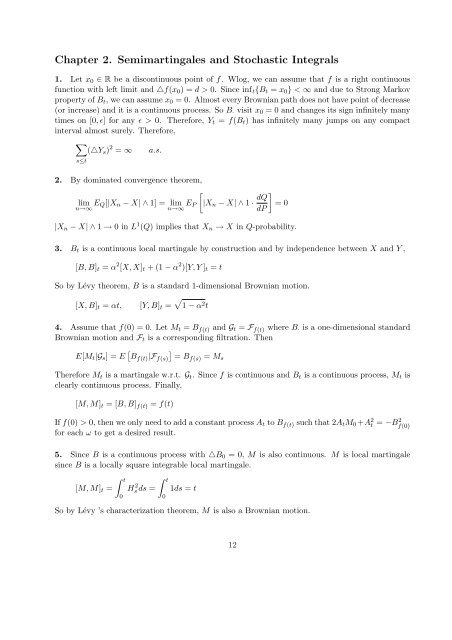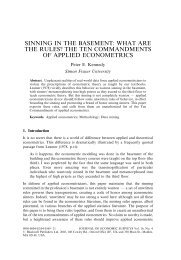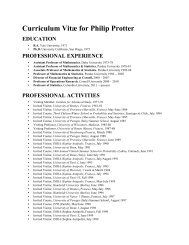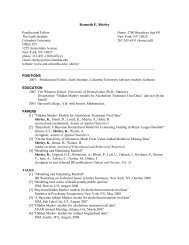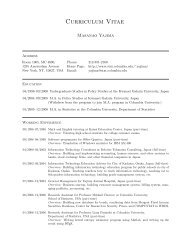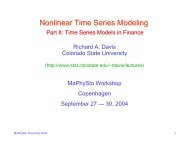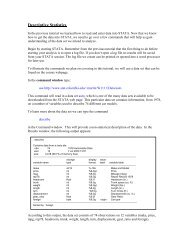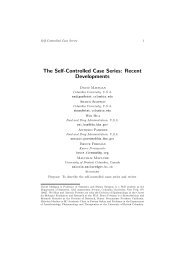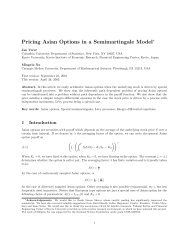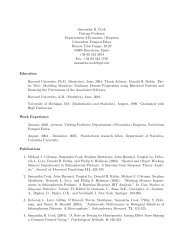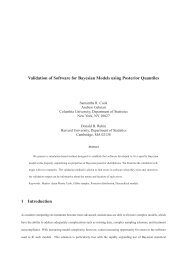Solution to selected problems.
Solution to selected problems.
Solution to selected problems.
Create successful ePaper yourself
Turn your PDF publications into a flip-book with our unique Google optimized e-Paper software.
Chapter 2. Semimartingales and S<strong>to</strong>chastic Integrals<br />
1. Let x 0 ∈ R be a discontinuous point of f. Wlog, we can assume that f is a right continuous<br />
function with left limit and △f(x 0 ) = d > 0. Since inf t {B t = x 0 } < ∞ and due <strong>to</strong> Strong Markov<br />
property of B t , we can assume x 0 = 0. Almost every Brownian path does not have point of decrease<br />
(or increase) and it is a continuous process. So B· visit x 0 = 0 and changes its sign infinitely many<br />
times on [0, ɛ] for any ɛ > 0. Therefore, Y t = f(B t ) has infinitely many jumps on any compact<br />
interval almost surely. Therefore,<br />
∑<br />
(△Y s ) 2 = ∞ a.s.<br />
s≤t<br />
2. By dominated convergence theorem,<br />
lim E Q[|X n − X| ∧ 1] = lim E P<br />
n→∞ n→∞<br />
[<br />
|X n − X| ∧ 1 · dQ<br />
dP<br />
]<br />
= 0<br />
|X n − X| ∧ 1 → 0 in L 1 (Q) implies that X n → X in Q-probability.<br />
3. B t is a continuous local martingale by construction and by independence between X and Y ,<br />
[B, B] t = α 2 [X, X] t + (1 − α 2 )[Y, Y ] t = t<br />
So by Lévy theorem, B is a standard 1-dimensional Brownian motion.<br />
[X, B] t = αt,<br />
[Y, B] t = √ 1 − α 2 t<br />
4. Assume that f(0) = 0. Let M t = B f(t) and G t = F f(t) where B· is a one-dimensional standard<br />
Brownian motion and F t is a corresponding filtration. Then<br />
E[M t |G s ] = E [ B f(t) |F f(s)<br />
]<br />
= Bf(s) = M s<br />
Therefore M t is a martingale w.r.t. G t . Since f is continuous and B t is a continuous process, M t is<br />
clearly continuous process. Finally,<br />
[M, M] t = [B, B] f(t) = f(t)<br />
If f(0) > 0, then we only need <strong>to</strong> add a constant process A t <strong>to</strong> B f(t) such that 2A t M 0 +A 2 t = −B 2 f(0)<br />
for each ω <strong>to</strong> get a desired result.<br />
5. Since B is a continuous process with △B 0 = 0, M is also continuous. M is local martingale<br />
since B is a locally square integrable local martingale.<br />
[M, M] t =<br />
∫ t<br />
0<br />
H 2 s ds =<br />
∫ t<br />
0<br />
1ds = t<br />
So by Lévy ’s characterization theorem, M is also a Brownian motion.<br />
12


